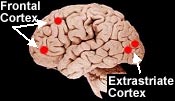 | Age Differences in Language Processing |
 | Age Differences in Language Processing |
|
By Melissa Lee Phillips Neuroscience for Kids Consultant June 17, 2002
| |
| One problem with some experiments designed to test differences
between
children and adults is that children tend to be slower and less accurate
at language tasks. Therefore, it is difficult to know if the results are
due to age differences or simply due to differences in ability. To get
around this problem, the researchers looked at children and adults whose
abilities were the same. They assumed that if the adults and the children
were equally good at the task, then any variations in brain activity would
be due only to age. The scientists found two major differences in the
brain activity of children and adults. The children had more activity in
the left extrastriate cortex and the adults had more activity in the left
frontal cortex. Both of these areas are known to be important in language
processing. This is the first study to show that adults and children may
be using these brain areas differently. Studies such as these are important to learn how adult human brains develop. By comparing young and old brains, researchers can begin to piece together a timeline of brain development. This knowledge may someday help in understanding and treating many developmental brain disorders. |
 Approximate location of differences in brain activity between adults and children. |
|
References:
|
| GO TO: | Neuroscience In The News | Explore the Nervous System | Table of Contents |
![[email]](./gif/menue.gif) Send E-mail |
 Fill out survey |
 Get Newsletter |
 Search Pages |
 Take Notes |